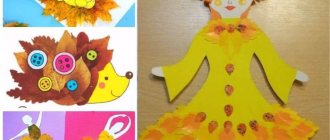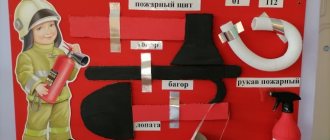A selection of didactic games and exercises on the theme “Autumn” for children of senior preschool age
Larisa Malysheva
A selection of didactic games and exercises on the theme “Autumn” for children of senior preschool age
Working as a speech development teacher at a preschool educational institution, my responsibilities include, in addition to conducting classes, organizing individual and preliminary work. I would like to bring to your attention didactic games and exercises aimed at developing coherent speech, the formation of the lexical and grammatical structure of speech and word formation skills in children of senior preschool age on the topic “Autumn”.
"Signs of Autumn"
Goal: to clarify children’s ideas about autumn signs, to activate vocabulary on the topic.
Equipment: story pictures depicting different seasons.
Procedure: The teacher offers children pictures depicting various seasonal phenomena (it is snowing, the sun is shining, an autumn forest, snowdrops in the forest). The child chooses pictures that depict only autumn phenomena and names them.
Looking at illustrations on the theme “Autumn”
Goal: Continue to expand children’s understanding of autumn, its signs and phenomena, continue to teach children to answer questions using common sentences.
Reading the poem by F. I. Tyutchev “There is in the original autumn”
Goal: To help children feel the beauty of nature in the poem, to enrich children’s speech with figurative expressions.
Conversation on the read work of I. Sokolov - Mikitov “Falling Leaves”
Goal: Continue to teach children to answer the teacher’s questions about the work they read, using grammatically correct sentences.
Did. game "One - many"
Goal: Continue to teach children to agree adjectives with nouns when changing number.
Progress: sunny day - sunny days; a beautiful tree-, a gloomy cloud-, a gray cloud-, cold rain-, a strong wind-, a flock of birds-, a deep puddle-, a rubber boot-... etc.
Did. game "Box with autumn tales"
Goal: Continue to teach children to use substitute objects as images when composing fairy tales.
Material: box, 6-8 circles of different colors.
Move: The player takes a circle out of the box, comes up with who it is or what it is in a fairy tale. After the player says 3-4 sentences, the second player begins (continues the tale). When the tale is told, the mugs are collected in a box.
Did. game "Say the opposite"
Goal: to activate adjectives with opposite meanings in children’s dictionaries.
Move: big - small, smart - stupid, light - dark, clean - dirty, kind - evil, cold - hot, sunny - cloudy, new - old, sad - cheerful, etc.
Did. ex. "Pick an action"
Goal: Continue to activate verbs in children's vocabulary.
Progress: What do leaves do in the fall? (turn yellow, fall, fly, etc.) Rain in autumn (fall, drizzle, etc.) Birds in autumn (fly away, get ready, etc.) Trees in autumn (drop leaves, fall asleep, etc.) Animals in the fall (preparing for winter, changing coats, etc.)
Introduction to sayings
Goal: Continue to teach children to understand the figurative meaning of proverbs and sayings.
“There is no turn from autumn to summer. Summer with sheaves, autumn with pies. In October, neither on wheels nor on runners. In September there is one berry, and even that bitter rowan. Autumn is stocky, winter is tidy. September is cold, but full
Did. game "Whose Leaves"
Goal: Continue to teach children to form possessive adjectives
Progress: The teacher invites the children to look at the pictures and determine which leaf of the tree is in his hands. (poplar leaf - poplar, birch, willow, rowan, oak, maple, etc.)
Development of coherent speech in children of senior preschool age Teaching coherent speech is one of the most difficult methodological tasks of preschool education and development. Development of coherent speech in preschoolers.
Playercube - a universal aid for the development of vocabulary and grammatical standing of speech GAME GUIDE “SPEECH CUBE” The speech cube or playerube is a universal aid for working with children, both junior and senior preschoolers.
Didactic game “Delicious gifts of autumn.”
Game "Vegetables and Fruits"
Author: Magdeeva A.F.
Target:
to form children's understanding of vegetables and fruits.
Tasks:
Educational:
teach children to recognize and name vegetables and fruits by appearance (name, color, shape).
Developmental:
develop visual perception, speech, thinking, memory.
Educational:
cultivate a desire to recognize vegetables and fruits. The ability to listen to the teacher and peers, help each other during the game.
Material:
a dummy bed with vegetables, a tree with fruits, attributes for the role-playing game “Shop”. Basket.
Progress of the lesson:
1. Game “Wonderful bag”
Didactic task:
learn to recognize vegetables and fruits and name them.
Game rules:
Place your hand in the bag and name one item by touch.
Game actions:
guessing vegetables and fruits without looking.
Progress of the game:
All children sit down at the table. The teacher lays out models of vegetables and fruits in front of them, while pronouncing their names, color and shape. Children carefully examine and touch the dummies.
Then the teacher puts vegetables and fruits in a bag and mixes them. After this, he invites the children to take turns putting their hand into the bag (without looking), select one object and name it according to its shape. The game is then repeated until all children have taken part.
2 .
Game “Vegetables (fruits) in a basket
Didactic task:
learn to distinguish and correlate objects by size, consolidate the concepts: big-small, one-many.
Game rules:
cut vegetables and fruits according to size.
Game actions:
Arrange vegetables and fruits in baskets.
Progress of the game:
The teacher invites the children to collect the harvest. Shows two baskets, specifying their size. Gives a task: you need to collect large fruits in a large basket, and small ones in a small basket.
3. Game “Fruit and Vegetable Store”
Didactic task
: form the concept of vegetables and fruits. Teach children to find fruits based on characteristic features: color, shape, taste.
Game rules:
Describe the purchase without naming it. Educator-buyer, child-seller.
Game actions:
find and sell vegetables and fruits according to description.
Progress of the game:
The teacher invites the children to play in the store and play the role of a seller (the game will take place in the “store” play corner). The seller must prepare everything for work: distribute the goods into the “fruits” and “vegetables” departments.
The buyer names the department where the product he needs is sold and describes it by its characteristic qualities. The seller names the purchase and gives it to the buyer.
Game-activity “Autumn” for children 3 years of age
Summary of a lesson in a playful way for children of the third year of life, topic: “Autumn”
Author: Davydova Svetlana Alekseevna.
Equipment:
Autumn leaves large and small. Leaves of yellow, red and green colors cut out of cardboard and vases (trays, bags, etc.) of the same colors. Puddles cut out of oilcloth. Nuts, a “squirrel” toy, a plastic bottle with a “hollow” cut out. Plasticine in yellow, red and green colors, sheets of paper with a painted tree. Wooden spatulas with red, yellow, green clothespins attached to them. Flowers and flower beds cut from egg cages, finger paints. Glue, sheets of paper with a background “autumn, tree trunks without a crown). Musical children's instruments. Audio recordings: “Waltz of the Flowers” by P. I. Tchaikovsky, song “Autumn, autumn has come, the leaves are falling.”
Didactic games for children about AUTUMN
October 10, 2017
The purpose of didactic games is the process of teaching children some knowledge and skills.
It's autumn outside, which means it's time for educational games for children about this wonderful time of year.
I offer you several such games for preschool and primary school children.
To play you need a ball.
An adult throws a ball to the child and names a tree.
The child returns the ball, while forming a phrase by adding an adjective to the name of the tree.
- birch - golden birch,
- oak - mighty oak,
- larch - red larch,
- spruce - prickly spruce...
Didactic games on the theme of autumn for preschoolers
Especially for children of preschool and primary school age, I have selected activities on the theme of autumn. They can be used both in kindergarten and at home.
All autumn games can be divided into several parts:
- A story about autumn (using cards, we compose a story about autumn together with the baby or on our own),
- logic exercises
- exercises to develop attention
- object sorting exercises
- games with flowers
- puzzles on the theme of autumn
- math fall games.
Autumn-themed story: Using thematic cards about autumn, compose a story with your child.
Thematic cards
You can download cards on the theme of autumn here - click on the pictures below and print them:
Pictures and tasks
the second option is a story about autumn with hand-drawn pictures - to download pictures on the theme of autumn for free, click on them:
A game to develop fine motor skills of the fingers on the theme of autumn - you need to circle the dotted line from the broom to the leaves:
Autumn games - here you need to sort into two columns - apples in one, leaves in the other:
Here you need to find the shadow of the object and connect the cards with each other:
We learn to sort leaves into large, medium and small:
Learning to count on the theme of autumn:
Puzzle with a stuffed animal - cut into pieces and put together with your child:
Puzzle with a squirrel is a more complex logic autumn game:
Autumn coloring - here you need to circle the acorn using the dots with numbers, and then color it:
Logical game on the theme of autumn - here you need to select an extra object in each line:
Another autumn game for sorting leaves by shade.
Print, cut into cards and sort from light to dark and vice versa:
Didactic games on the topic: “Autumn”
Description:
Didactic games on the topic: “Autumn”
Age: senior preschool age (5 - 6 years).
Head : Ekaterina Vladimirovna Moskovskaya.
The goal of the project : to clarify and consolidate knowledge on the topic “Autumn” in the senior group with speech impairments (OSD).
To develop the child’s speech, teach him to think independently, reason, and express his thoughts consistently and logically.
Tasks:
Educational:
- To consolidate children's knowledge about seasonal changes in nature.
- Continue teaching children to compose stories from pictures with sequentially developing events.
- Learn to form nouns in R. p.; in plural h.
Educational:
1. Continue to develop children’s speech activity.
2. Continue to develop coherent speech, expand and enrich your vocabulary on the topic.
3. Develop attention, memory, thinking.
4. Develop interest in knowledge about nature
Educational:
1. Cultivate a sustainable interest and interest in getting to know the nature of your native land;
2. Develop communication skills in communicating with adults and peers, encourage interest in joint gaming activities, and cultivate mutual understanding.
Implemented educational areas:
- Cognitive development.
- Social and communicative development.
- Speech development.
This project was created using MimioStudio software.
The project contains 21 pages. Each page is equipped with hyperlinks: old man - Lesovichok returns to the main page (game - walker) to continue the game.
Each page has instructions with tasks that slide out when you pull the red maple leaf. At the end of the game, the teacher clicks on the arrow on the right side of the sheet and follows the hyperlink to the last page - “portrait of Autumn.”
PAGE No. 1. Title page
PAGE No. 2. Contents of the project.
PAGE No. 3. Mnemonic table “Signs of autumn” - children, based on pictures, remember the signs of autumn. At the end of the conversation with the children, the old man - Lesovichok invites the children to play a game (follow the hyperlink to the game)
PAGE No. 4. Game - walker. The child clicks on the cube, names the number that comes out, takes a maple leaf with a stylus or hand and, starting with the number 1, takes steps forward. When stopping, the piece of paper remains behind the number, which means that there will be no more stopping here, then the child clicks on the number and uses a hyperlink to go to another page with the task. After completing the task, the child clicks on Lesovich and returns to the main page. The next child begins to count steps from the next number, not covered by a piece of paper, and steps over them along the way.
Goal: to arouse children's interest in activities.
PAGE No. 5. Sudoku. The child visually identifies and uses a stylus to move the animal to its place so that it is not repeated twice, either horizontally or vertically. If the child makes a mistake and clicks on the monkey, it will automatically be crossed out.
Goal: develop attentiveness and patience.
PAGE #6: Confusion. The child needs to look at pictures depicting the seasons, find mistakes and move them to their place, while explaining his actions.
Goal: to develop attentiveness, the ability to explain why the picture taken should be moved, and learn to justify your answer.
PAGE No. 7. Graphic dictation. The child selects a pencil from the tools, performs actions under the dictation of the teacher and guesses which animal it turns out to be (the answer is behind the curtain).
Goal: to develop fine motor skills and attentiveness.
PAGE No. 8. Find the number 2. Among the scattered leaves, you need to find those with the number 2 on them and use a Marker or Pencil (in the tools) to put a dot. When the child finds all the leaves on the field, he will see a large number 2; if desired, he can connect the dots.
Goal: To train children in the ability to find from a large number of pictures the one that is needed for the task. Develop mindfulness.
PAGE No. 9. Vegetable preparations. The child puts tomatoes and cucumbers into jars and counts them, answering the questions: how many? What is more, what is less?
Goal: strengthening the skills of ordinal counting, the ability to answer a question with a complete answer.
PAGE No. 10. Find a pair. The child repeats the names of colored autumn leaves, which tree they come from, chooses non-colored pictures and puts them into pairs.
Goal: development of concentration and logical thinking.
PAGE No. 11 . My fruits. The child selects a ball, clicks on it and says what fruits he sees, starting the sentence with the words “Mine...”.
Goal: learn to form nouns in the plural.
PAGE #12 : Find the shadow. The child takes a pencil, draws lines from the shadow to the animals in the picture, while naming the selected animals.
Goal: Development of visual attention.
PAGE No. 13. “How to grow tomatoes” The child looks at the pictures, moves them in the right order and composes a story based on the pictures with sequentially developing events.
Goal: continue to teach children to write a story using pictures.
PAGE No. 14. How does the color of a fur coat change with the arrival of winter? The teacher talks with the children about changes in the appearance of some animals before the onset of winter. Then the teacher moves the animals behind the tree and shows how the color of their fur coat changes.
Goal: development of visual-figurative thinking, attention, memory, ability to find cause-and-effect relationships.
PAGE No. 15. Vegetable salad. Having learned the task, the child selects from the proposed pictures those that correspond to the task and clicks on them. If the child is right, a tick appears; if not, a cross appears.
Goal: development of attention, logical thinking.
PAGE No. 16. Autumn landscape. The child can move the pictures onto and under the tree to create an autumn landscape. During the activities, the child tells what he is doing.
Goal: to develop the child’s coherent speech.
PAGE No. 17. Repeat the pattern. The child examines the pattern of autumn leaves and repeats it in the neighboring field, moving the colored leaves in the required quantity.
Goal: activation of cognitive activity through game elements.
PAGE No. 18. Find the fungus at the address. The child examines a field with mushrooms and a table with suggested tasks. Then it finds the desired mushroom and moves it to the table.
Goal: development of attention, logical thinking.
PAGE No. 19. Harvest apples. The teacher puts a number on the basket, and the child collects the same number of apples in the basket.
Goal: to consolidate counting skills in an entertaining way.
PAGE No. 20. Where do vegetables grow and where do fruits grow? The child moves pictures with vegetables and fruits into the proposed windows of the table, pronouncing and justifying his actions. The test area appears when you click on the triangle to the right of the table.
Goal: development of concentration and logical thinking.
PAGE No. 21. End of the project. " Portrait of Autumn."





